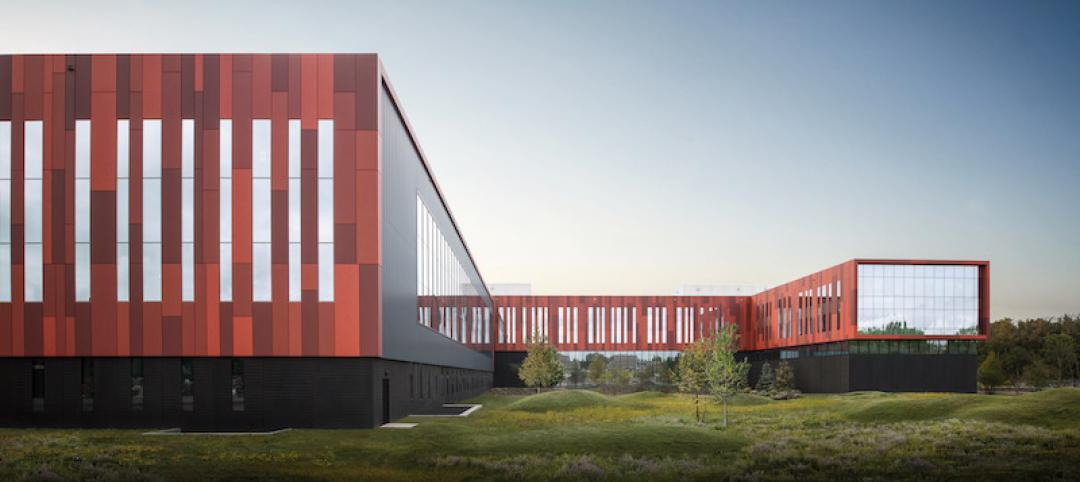From modular schools to a “test” classroom, green construction in the K-12 schools market has taken on many forms in the past decade. With school districts having to keep the needs of students in balance with limited budget flexibility, Building Teams around the country are finding ways to bring green schools into reality, whether by new construction or extensive renovation.
Chula Vista, Calif., charter school High Tech High was advised by San Diego-based general contractor BYCOR to turn to modular construction for its campus. Faced with a tight deadline and strict budget, the project also was working toward a variety of green goals, including LEED.
Modular manufacturer Williams Scotsman was brought on board to coordinate the integration of modular construction with the overall project; 59 modules totaling 32,807 sf were provided for the school, which was awarded LEED for Schools Gold certification.
In 2011 Dills Architects and McKenzie Construction completed the 94,231-sf College Park Elementary School in Virginia Beach, Va., with LEED Platinum certification in mind and net-zero stormwater management to boot. To meet the latter goal, the Building Team specified green vegetative roofing and cisterns for rainwater collection.
One Firm, multiple green certifications
Design firm SHW Group, Plano, Texas, draws from a variety of certification programs and rating systems to help build green.
The 105,000-sf Gloria Marshall Elementary School in Spring, Texas, was the first school in the Houston area to use geothermal heating and cooling. In addition to LEED Gold certification, the school received an Energy Star rating and was designed to meet Texas/CHPS (Collaborative for High Performance Schools) criteria.
The Fine Arts Facility at the 23,700-sf McCallum High School in Austin was the first educational facility in Texas to receive a five-star rating from the Austin Energy Green Building Program, the nation’s first comprehensive green building program. SHW saved the school district nearly $1 million by converting existing art rooms into science labs, building a new fine arts facility for theatre and art, and connecting the existing school with the fine arts facility.
The school also includes a “breathable” membrane that uses metal wall panels to keep moisture from getting trapped inside the wall. It is anticipated thait this will result in improved energy efficiency and indoor air quality for the school.
Green construction has also spread to the U.S. Military Academy Preparatory School at West Point, N.Y. The elite prep school moved to its new location after the former site in Fort Monmouth, N.J., was closed as part of the 2005 Base Realignment and Closure Act. The Building Team of STV (architect/engineer) and J. Kokolakis Contracting (GC) earned LEED Gold for the new facility. Environmentally conscious building practices included the procurement of materials with high recycled content, selling unused building materials to nearby manufacturers, and diverting 98.5% of C&D waste from landfill.
Many school districts, notably in California, are simultaneously implementing green building practices while using the buildings themselves to teach environmental principles to students. One such classroom, at the Davis Magnet School in Costa Mesa, was retrofitted with environmentally friendly flooring, furnishes, and paints, as well as high-performance lighting and a new ventilation system. A neighboring classroom was left unimproved.
The resulting experiment has students comparing the two classrooms to learn firsthand the benefits of sustainable educational environments. What’s more, the “greenovation,” according to Irvine-based architecture firm LPA Inc. and the Orange County chapter of the U.S. Green Building Council, came at zero cost to the school, having been funded through private donations. +
Related Stories
University Buildings | Aug 16, 2016
New images of Rice University’s Moody Center for the Arts revealed by Michael Maltzan Architecture
The arts center will foster creativity for making and presenting works across all disciplines
Designers | Aug 16, 2016
CCDI, Morphosis, and Diller Scofidio + Renfro are among ten finalists vying for Chinese Eco-Island design
The winning firm will design the master plan and central buildings for the man made Haikou Bay island.
Mixed-Use | Aug 16, 2016
Goettsch Partners completes mixed-use tower in R&F Yingkai Square
The 66-story building is now the 7th tallest completed building in Guangzhou.
| Aug 15, 2016
SPORTS FACILITY GIANTS: New and renovated college sports venues - designed to serve students and the community
Schools are renovating existing structures or building new sports facilities that can serve the student body and surrounding community.
| Aug 15, 2016
Top 50 Sports Facility Architecture Firms
Populous, HKS, and HOK top Building Design+Construction’s annual ranking of the nation’s largest sports facility sector architecture and A/E firms, as reported in the 2016 Giants 300 Report.
| Aug 15, 2016
MILITARY GIANTS: Cross-laminated timber construction gets a salute from the Army
By privatizing the construction, renovation, operation, maintenance, and ownership of its hotels the Army expects to cut a 20-year timetable for repairs and replacement of its lodging down to eight years.
| Aug 15, 2016
Top 30 Military Architecture Firms
HDR, Clark Nexsen, and Guernsey top Building Design+Construction’s annual ranking of the nation’s largest military sector architecture and A/E firms, as reported in the 2016 Giants 300 Report.
| Aug 12, 2016
SCIENCE + TECHNOLOGY GIANTS: Incubator model is reimagining research and lab design
Interdisciplinary interaction is a common theme among many new science and technology offices.
| Aug 12, 2016
Top 40 Science + Technology Architecture Firms
Perkins+Will, HDR, and HOK top Building Design+Construction’s annual ranking of the nation’s largest science + technology sector architecture and A/E firms, as reported in the 2016 Giants 300 Report.
| Aug 12, 2016
OFFICE GIANTS: Technology is giving office workers the chance to play musical chairs
Technology is redefining how offices function and is particularly salient in the growing trend of "hoteling" and "hot seating" or "free addressing."

















